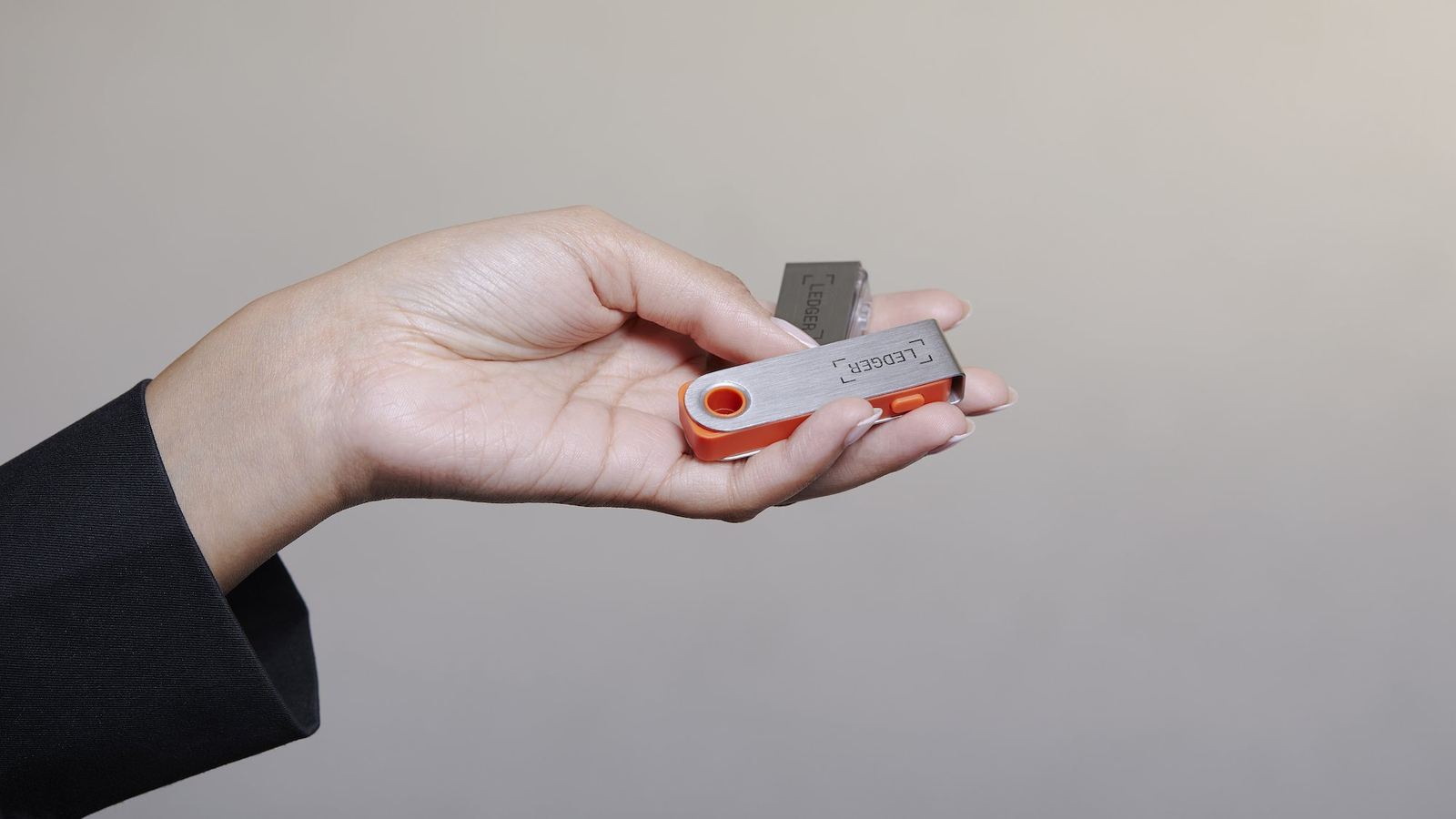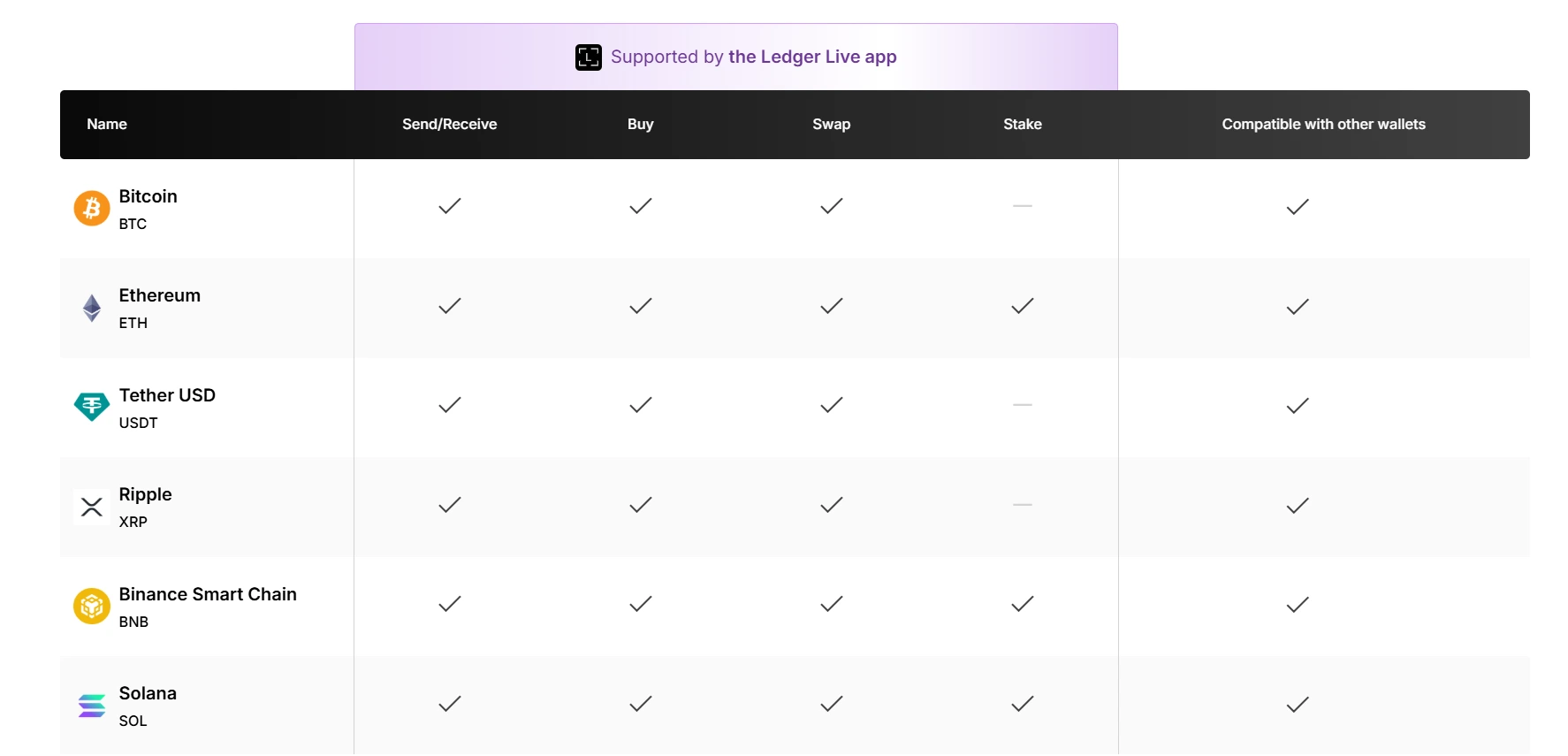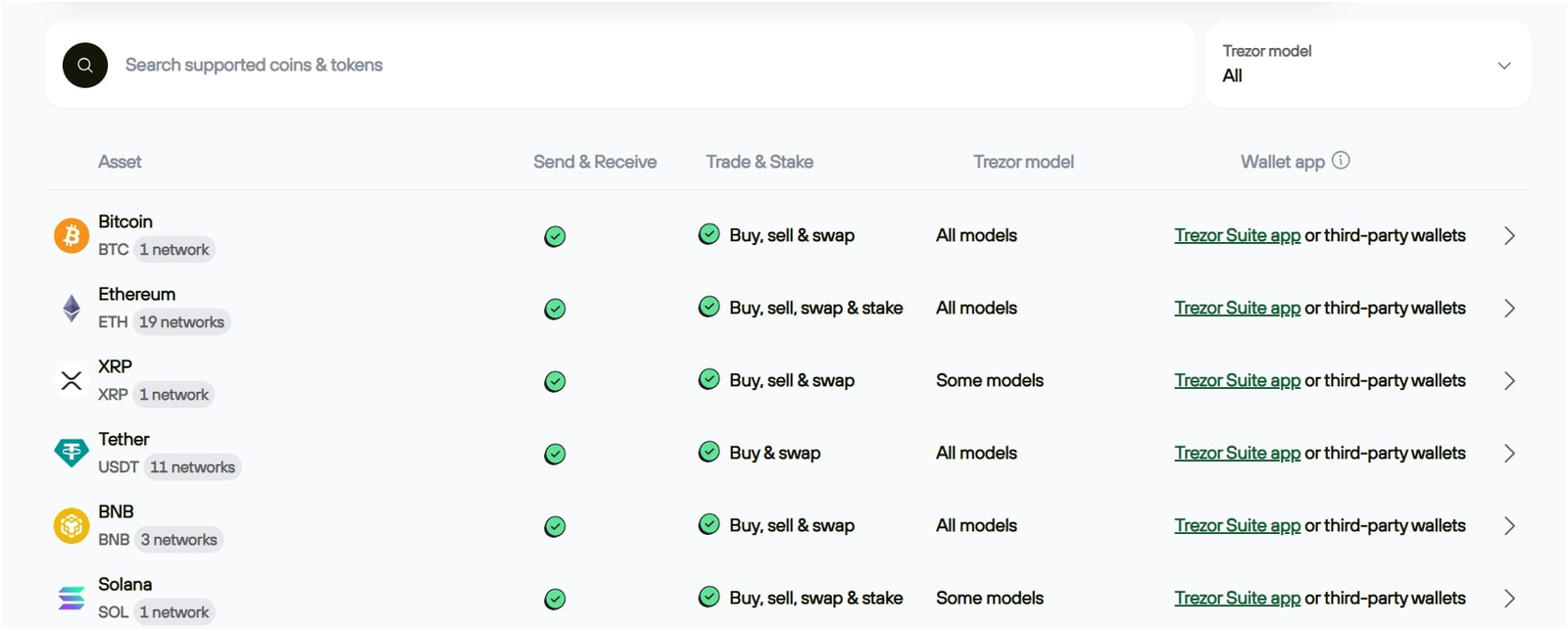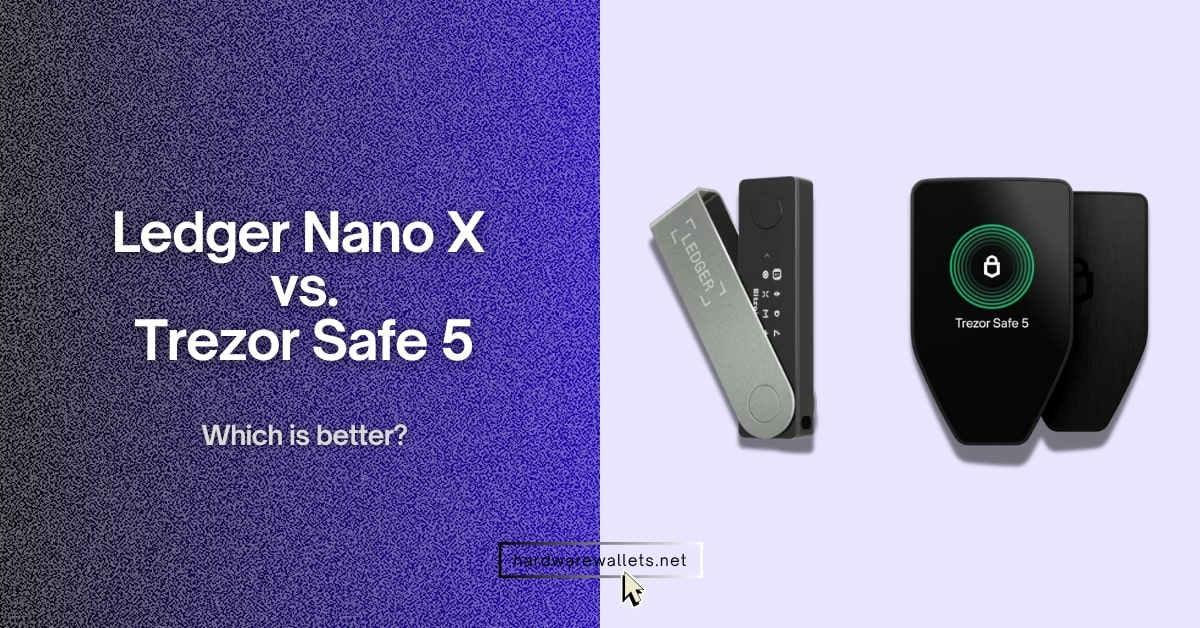Key Differences
- Security-wise: The Safe 5 feels more transparent and open. Mainly because It uses an EAL6+ secure chip, supports Shamir Backup, and lets anyone review its open-source code. The Nano X is also quite safe but relies on a closed EAL5+ chip and proprietary software, so I believe you have to trust Ledger more than verify it yourself.
- Supported digital assets: Both support most of the popular coins, but the main difference here is, Nano X supports NFTs and staking, whereas Safe 5 has limited or no support.
- Mobile usability: The Nano X is far user-friendly for mobile users due ot its Bluetooth support, whereas Safe 5 works only with desktops or laptops. Actually, Trezor Suites has an Android Lite version with limited features only, and its iOS app is only in read-only mode.
- Privacy Features: Trezor Safe 5 takes the lead here. It includes Coin Control to hide your spending patterns, Tor integration for anonymous network use, and full open-source transparency. Ledger Nano X doesn’t offer built-in privacy tools, so you depend more on external apps.
- Price: Ledger Nano X usually sells for around $149, while Trezor Safe 5 is closer to $169.
Quick Comparison: Nano X vs. Safe 5
| Criteria | Ledger Nano X | Trezor Safe 5 |
|---|---|---|
| Release Year | 2019 | 2024 |
| Price (USD) | About $149 | About $169 |
| Product class | Mobile-first, Bluetooth-enabled hardware wallet | Touchscreen hardware wallet focused on privacy + security |
| Dimensions | 72 × 18.6 × 11.75 mm | 65.9 × 40 × 8 mm |
| Weight | 34 g | 23 g |
| Body / materials | Brushed stainless steel cover + plastic body | All-glass front with Gorilla® Glass 3 |
| Display | 1.09″ monochrome OLED, 128×64 px (two physical buttons) | 1.54″ color touchscreen, 240×240 px with haptics |
| Haptic feedback | No | Yes (Trezor Touch haptic engine) |
| Connectivity (wired) | USB-C | USB-C (USB-C→USB-C cable included) |
| Connectivity (wireless) | Bluetooth® (mobile only) | No Bluetooth (USB only) |
| Battery | 100 mAh Li-ion built-in | No battery (USB-powered) |
| Secure element | ST33J2M0, CC EAL5+ certified | NDA-free Secure Element, EAL6+ certified |
| Firmware / OS | BOLOS (proprietary) | Open-source security & design |
| Main companion app | Ledger Live (desktop + mobile) | Trezor Suite (desktop & web; Suite Lite on mobile) |
| iOS support | Ledger Live Mobile iOS 14+ via Bluetooth | View-only on iOS (no cable signing) |
| Android support | Full via Bluetooth; USB on desktop | Android supported via USB with Suite Lite |
| Desktop OS | Windows/macOS/Linux (Ledger Live) | Windows/macOS/Linux (Suite desktop) + Suite Web |
| Recovery phrase | 24-word Secret Recovery Phrase | 12/20/24-word backups |
| Advanced backup | Passphrase (“25th word”) on-device | Passphrase on-device; Advanced Multi-share Backup (Shamir-style) |
| microSD features | No microSD slot | microSD slot; optional MicroSD hardware encryption to bind device to card |
| App / coin installs | Up to ~100 apps (varies by app size) | Not app-based; coin support built into firmware / Suite |
| Supported assets (official claim) | 5,500+ coins & tokens with Ledger Live + partners | “Thousands of coins & tokens”; Suite + third-party wallets |
| On-device UX | 2 buttons + OLED (no touch) | Full color touchscreen + haptics; custom 240×240 wallpaper |
| Extras (privacy & tools) | – | Coin control, Tor routing options in Suite; can act as FIDO2 2FA device |
| Operating temperature | – | −20 °C to +60 °C |
| Mobile/desktop Bluetooth notes | Mobile Bluetooth; cannot Bluetooth-pair to Ledger Live desktop | – (no Bluetooth) |
| Firmware/OS updates | Mobile OS updates & firmware; recent releases note BT speed improvements | – |
| Box contents | Device, USB-C→USB-A cable, recovery sheets, strap, leaflet | Device + USB-C cable |
Why I like Nano X more than Safe 5?
I like the Ledger Nano X far more because it simply feels more convenient and flexible to use than the Trezor Safe 5. It holds well over 15,000 coins and tokens, and that makes a huge difference if you hold a combination of top coins and smaller altcoins.
The Safe 5 actually supports Bitcoin and roughly a thousand assets, which may be okay for someone who has a niche portfolio, but I don’t want to have to concern myself with whether some new coin I purchase will be supported or not.
And there’s also the portability factor. The Nano X has Bluetooth and a tiny rechargeable battery, so you can sign transactions right off your phone without being tethered to a cable. Mainly, it’s a small, USB stick-shaped device that can easily be attached to a keychain.

The Safe 5 also lacks wireless connectivity and relies on a USB-C cable for power and data. Though lighter, you can not use it with your iOS devices due to the lack of connectivity options. So, there is no point in portability unless you carry your laptop with you.
Honestly, I am totally fond of how convenient the Ledger is to carry around, and you likely would be too.
Ledger Live, the companion app, supports staking, swapping, and NFT functionality. I’ve found most DeFi sites and wallets connect nicely with Ledger, so you don’t spend time searching for workarounds.
Trezor Suite is good, but it has fewer integrations and no native staking and NFT support.
And lastly, the price makes Ledger the value play; Nano X is about $149, while Safe 5 is nearer to $169. It’s not a big difference, but to get less money and more features, and also Bluetooth, seems like the wiser choice.
How do they differ in terms of security?
Winner: Trezor Safe 5
Actually, both of these crypto hardware wallets store your assets with secure chips and offline key storage, but the overall security model feels very different from each other.
Nano X has a closed-source firmware with a CC EAL5+ certified secure element and its own operating system, BOLOS. You can’t view the whole code, so you’re placing quite a lot of trust in Ledger’s engineers. Well, it’s not terrible, but you’re actually trusting their assurance that all is secure behind closed doors.
Trezor goes the opposite direction. Safe 5 employs a more recently developed EAL6+ secure element that’s completely NDA-free, so researchers can easily test and examine it.
Its software and firmware are open source, so anyone can review the code.
Honestly, I believe Safe 5 is the winner here, not only because of the level of certification, but because you can actually inspect what’s operating on your device rather than hoping for the best.
Trezor Safe 5 also has more embedded privacy features.
- You can use “Coin Control” and select which exact coins you wish to send, protecting your history of past transactions. It operates directly within Trezor Suite, and that matters if you’re concerned about the appearance of your spending history on-chain.
- There’s also “Tor” integration, so you can have your wallet traffic go through the Tor network directly from the app.
- Additionally, Safe 5 has Shamir Backup (SLIP-39) support so you can divide your recovery seed into multiple shares. Even if you do lose one piece, your money remains secure. You can always opt for a plain 12- or 24-word backup, if you like, but the multi-share configuration provides another buffer.
Nano X, however, retains the default 24-word recovery phrase. It even provides a paid recovery option that divides your seed among three custodians, although many users aren’t keen on that concept.
The Nano X uses a shorter 4 to 8-digit PIN, but the Safe 5 allows you to specify a much longer one, up to 50 digits, and you can input it directly on the touchscreen rather than via phone or computer. That’s a definite security bonus.
Both companies have dealt with vulnerabilities in the past, but they’ve learned from them. Ledger’s had data breaches that leaked customer info (not seeds), while Trezor’s older models were once exposed to physical attacks before the secure element was introduced. Hence, both brands now patch quickly whenever issues appear.
In the end, I’d say Nano X’s strength is convenience, but Safe 5 clearly leads in transparency, privacy, security, and user control.
Which wallet supports more coins, Ledger Nano X or Trezor Safe 5?
Winner: Ledger Nano X
The Ledger Nano X supports significantly more coins and tokens than the Trezor Safe 5. And, the difference is pretty substantial, too, not just a bit.
The Ledger Nano X can generally store over 15,000 different crypto assets. And, this includes basically all the major coins like Bitcoin, Ethereum, and Solana, plus a huge variety of smaller tokens and NFTs. You need to mainly use the Ledger Live application for this purpose, which is really an all-in-one platform for your crypto, as you can easily buy, sell, swap, and stake your assets all in one place.

Now, the newer Trezor Safe 5 supports over 9,000 different coins and tokens through its Trezor Suite software. Yes, that’s plenty for most people, especially if you mainly deal with the big coins. But to manage all these coins, you need to use third-party wallets like MetaMask or Exodus.

So, honestly, if you’re a serious collector or someone who invests in a lot of different, maybe less common, projects, the Nano X has a clear advantage simply because of its much broader software app compatibility.
Trezor Suite is not that good compared to the Ledger Live app.
Final Verdict: Which is Better?
The better hardware wallet really depends on you and how you plan to use it. Here, there isn’t a single winner, to be honest. It’s all about your personal priorities…
You should totally pick the Ledger Nano X if:
- You need mobility: The built-in Bluetooth is a must-have if you manage your crypto mainly on your phone (iOS or Android). The Safe 5 does not support iOS devices.
- You have a huge, varied portfolio: Well, with support for over 15,000 assets, you’ll pretty much find every coin you own. Even Nano X also supports NFTs and staking. Now, comparing this Safe 5, you need third-party wallets for all these; Trezor Suite does not have these functionalities.
- You want to save a bit of money: The $149 price tag is a slight edge compared to $169, but not too much.
Read my in-depth Ledger Nano X review here…
You should basically go for the Trezor Safe 5 if:
- You prioritize transparency, privacy, and top-tier device security: The fully open-source code and the higher-rated EAL6+ Secure Element will give you a bit more peace of mind. Also, Safe 5 has more security and privacy features like: Shamir backup, Tor browser support, Coin Control, and CoinJoin. So, I feel it’s more secure compared to Nano X.
- You want the best possible user experience: The large, vibrant color touchscreen makes interacting with the device much smoother and more pleasant. Generally, it’s just a nicer piece of cold wallet to use.
- You mainly use a desktop or stick to major coins: Since it lacks Bluetooth, it’s best for people who mostly access their crypto from a computer.
You can also read my honest Trezor Safe 5 review…
So, here’s my quick final takeaway of Ledger Nano X vs. Trezor Safe 5: Get the Nano X for maximum coin support and freedom to manage on your phone. Get the Safe 5 for a more premium experience, higher rated security hardware, and full open-source transparency. Yes, both are excellent choices, so you’re in a good spot either way. Just pick the one that fits your daily routine best.
Read more guides: Ledger vs Trezor comparison and best cold storage wallets.
